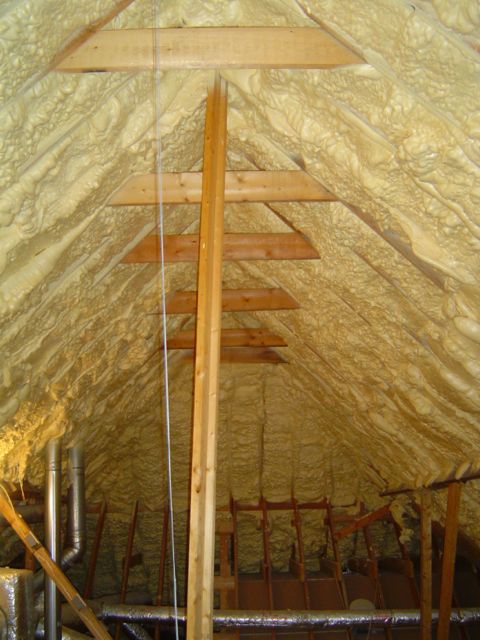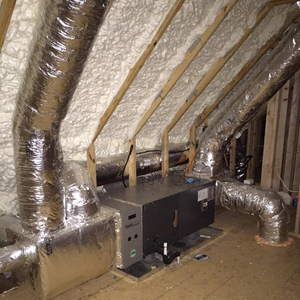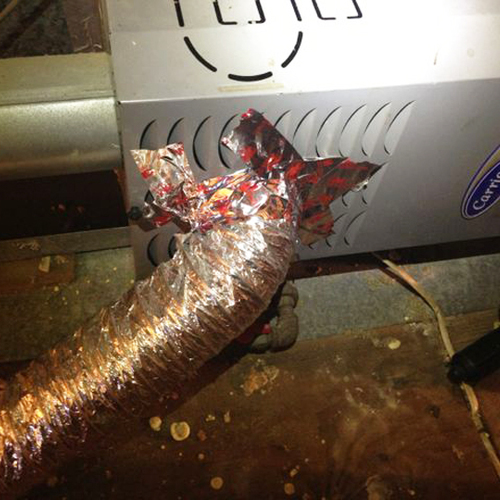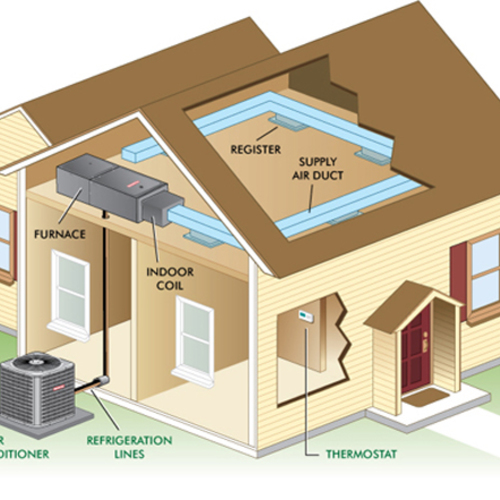
Image Credit: Energy Vanguard
Earlier this year I got a question about a home that had spray foam insulation in the attic. There’s nothing unusual about that. A lot of builders and homeowners are going with spray foam insulation because of the airtightness benefits.
But then the questioner mentioned that the spray foam contractor had intentionally left big holes to the outside by not sealing the gable vents.
A case of incompatibility
The attic you see in the photo here is a different home, but it does have one feature in common with the house I’m talking about, besides the spray foam. If you look closely, you’ll see two exhaust flues on the left side of the photo. (You’ll also see another safety hazard and code violation: The installer sprayed foam directly on the metal flues. You should never do this!) Those metal pipes indicate to the trained eye that this house has atmospheric combustion appliances.
In the photo here, the furnaces were down in the conditioned space, but in the house my friend asked about, the two furnaces were in the attic. They also were of the atmospheric combustion type.
See where I’m going with this yet? The spray foam contractor on that job saw the two atmospheric combustion furnaces in the attic and knew they needed combustion air from the space around them. If he had sealed up the attic completely, where would the furnaces get combustion air?
Aha! That’s why they didn’t seal the gable vents. Now when those furnaces run, they can pull in the combustion air they need through those holes.
But wait. If the homeowners are getting spray foam on their roofline to make the home more airtight, why would they leave big holes to the outside?
Oops!
A house is a system
It’s nice that the spray foam insulation contractor recognized the need for combustion air in that case. In many, they don’t get that far. Whether you’re building a new home or retrofitting an existing home, though, you’ve got to remember that the hip bone’s connected to the thigh bone; or, as we say in building science, a house is a system.
Newer homes have to meet building codes that help prevent this problem. If there are atmospheric combustion appliances inside the building enclosure, the HVAC contractor is required to install vents that are supposed†to bring combustion air into the room where the appliances are located. If the atmospheric combustion appliances are located in a vented attic, the building code doesn’t require those vents because the appliances are already located in a well-vented area that is connected to the outside. But if you move the building enclosure to the roofline with spray foam insulation, where will the combustion air come from?
Whether the home is old or new, however, anyone considering spray foam insulation would be wise to ask this question: What impact will encapsulating the attic have on the HVAC system(s)?
This question applies to encapsulated crawl spaces as well.
If you have atmospheric combustion in the home now, it might be best to wait and do the spray foam after you’ve replaced the old equipment with sealed combustion, power-vented, or direct vent appliances. If the house isn’t built yet — or at least doesn’t have the HVAC equipment installed yet — make sure there are no atmospheric combustion appliances going inside the building enclosure.
Remember: A house is a system.
Allison Bailes of Decatur, Georgia, is a speaker, writer, energy consultant, RESNET-certified trainer, and the author of the Energy Vanguard Blog. You can follow him on Twitter at @EnergyVanguard.
Footnote:
†Keep in mind that passive vents may not be the answer. My friend David Richardson, an instructor with the National Comfort Institute, likes to point out that the high-low vents required by code don’t always do what they’re told. “The issue is it’s a two way street for airflow,” he says. “It’s common to see combustion air ducts and grilles functioning in direct opposition to their original design intent.”
Weekly Newsletter
Get building science and energy efficiency advice, plus special offers, in your inbox.














6 Comments
Thanks for a useful article
I appreciate your posting and the issues that you explain.
Mr. Bailes- Make-up air duct, instead of the open gable vents?
Mr. Bailes,
It's unfortunate to see good intentions- and dollars- wasted.
It's been a while since you wrote this. Did you have a recommendation? Did they take your advice?
Sealing the gable vents and upgrading the furnaces is probably the best solution, but if they weren't ready for that, would a single (insulated?) make-up air duct- dumping outside air right next to the furnaces- have been preferable to the multiple open gable vents? I realize that due to the stack effect, it might sometimes blow out instead of in- especially when the furnaces weren't operating- but wouldn't it be preferable to the open gable vents? With the gable vents, I imagine outside air- driven by the wind- blowing in one end, right thru the attic and out the other end- all the time.
Thanks,
Ben
Response to Ben Rush
Ben,
Like you, I look forward to Allison Bailes's opinion. But here's my opinion: you can't create a sealed, conditioned attic if you have any atmospherically vented appliances in the attic. It is necessary to first install new sealed-combustion appliances before proceeding with this type of insulation job. For more information, see Creating a Conditioned Attic.
But what about THIS case?
Mr. Holladay,
Thanks for referring me to your Conditioned Attic post. It is a great summary and collection of useful info on the topic. I'll refer to it as I plan a couple projects of my own.
When I inquired previously about installing a make-up air duct and sealing the gable vents, I didn't mean to suggest going this route intentionally. My proposed "improvement" was only for this particular situation- in which the spray foam and the furnaces are already there. In the situation as Mr. Bailes found it, would my "improvement" be an improvement?
Thanks,
Ben
Response to Ben Rush
Ben,
Q. "My proposed 'improvement' was only for this particular situation - in which the spray foam and the furnaces are already there. In the situation as Mr. Bailes found it, would my 'improvement' be an improvement?"
A. If you have already installed spray foam to create an unvented conditioned attic, and if your attic contains atmospherically vented combustion appliances, you have made a big mistake and created a dangerous situation. I advise you to replace your existing appliances with new sealed-combustion appliances.
Don't worry (about ME)
Mr. Holladay,
While I appreciate your concern very much, you don't need to worry. (This time.) I make LOTS of mistakes, but I haven't made this one. I was only wondering about the house Mr. Bailes wrote about.
I understand you're saying the owner of that home should immediately get new sealed combustion appliances- and not waste time with my make-up air duct idea. Got it. Good enough for me.
Thanks,
Ben
Log in or create an account to post a comment.
Sign up Log in